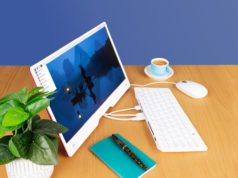After ditching its proprietary OS for Android, BlackBerry has released only one smartphone featuring the brand’s staple physical keyboard – the BlackBerry Priv which launched in 2015 to a resounding ‘meh’. Now, in partnership with Chinese manufacturer TCL, another Android handset bearing the BlackBerry name and featuring a QWERTY keyboard is poised to hit the market in the form of the BlackBerry Mercury/DTEK70.
While this is simply a code name for the device, we will be sticking to it for now, as it is currently the only officially confirmed moniker for the upcoming phone. We had the chance to take the Mercury for a spin at CES earlier this month, but there is still quite a bit of mystery surrounding the device. There will be more concrete information available as MWC draws in, but for now, here is everything we currently know about the upcoming BlackBerry Mercury/DTEK70:
The upcoming BlackBerry Mercury’s most prominent design feature is its true-to-brand physical QWERTY keyboard. Unlike the Priv, however, the new phone doesn’t feature a slide-out design, meaning that the keyboard can’t be hidden and is always at your fingertips. While this will decrease the phone’s thickness considerably, especially when compared to the Priv, the four rows of keys will also eat quite a bit of display real estate. Due to this change, the Mercury has a considerably smaller screen that its predecessor – around 4.5 inches against the 5.4 on the Priv.
The backlit QWERTY keyboard also packs a few neat tricks to boot – not that its very existence on the front of a 2017 smartphone isn’t surprising in its own right. There is a fingerprint scanner built into the space bar and the entire keyboard acts as a de facto touch pad, allowing you to navigate the UI by swiping over the keys.
As far as built quality goes, the phone’s body is primarily made out of metal, with the exception of its back, which is covered in a textured leather-like material that provides a nice grip on the device. The top of the Mercury is completely flat and features everybody’s favorite 3.5mm headphone jack, while the bottom is rounded and sports a USB Type-C port and a speaker grill. On the right side you will find the SIM card slot, volume rocker and power button, while on the left is located a neat surprise in the form of a programmable button.
Overall, the Mercury looks bulky, at least when compared to most other smartphones on the market, but stays true to the brands’ identity by featuring design choices sure to be appreciated by long-time BB fans. The question is, what about the rest? The QWERTY keyboard will either be a deal-breaker or a killer feature.
While TCL was happy to share an advanced sneak peek at the at the phone with us at CES, its specs and capabilities are still not public. Previous rumors about the Mercury suggest a 4.5-inch display with a resolution of 1080 x 1680 — decidedly lower than the Priv’s 2K resolution of 1440 x 2560 pixels — and a rather disappointing Snapdragon 821 at the heart of the device. Given that the Priv packed 3GB of RAM, it’s a pretty safe bet that the Mercury will either bump this to either 4 or 6 GB, or come out with the same amount, which would be rather disappointing in its own right. We can’t say anything about the cameras on the front and back of the device at this point.
- Software & user experience
The Mercury will run a near-stock version of Android 7.0 Nougat at launch, while BlackBerry’s mobile team will continue to issue security updates, including Google’s monthly patches. From what we’ve seen at CES, the user interface feels very similar to stock, with the exclusion of some proprietary tweaks and pre-installed apps.
User experience
While so many hardware questions remained unanswered, our hands-on time with the BlackBerry Mercury was enough for us to get a better understanding of the software of things. For example, we saw the return of features we got familiar with on the Priv, like BlackBerry’s unique grid-based app switcher. But much like the phone’s internal components, its software is also something with a bit of mystery surrounding it, and we likely won’t have a full sense of what to expect until the Mercury’s official launch draws closer.
The BlackBerry of today is not like the BlackBerry of yesteryear. That much should be clear from the get-go. The mobile landscape too is vastly different from what it was during the company’s heyday. If the Priv is anything to go buy, the Mercury will likely not be able to capture the mainstream appeal of BlackBerry’s old devices, but maybe that isn’t its goal to begin with. The Priv suffered from such problems as finicky GPS and Bluetooth connections, inconsistent call quality, and slowed down quite a bit after only a few months of usage. All of these can be fixed with the Mercury, and if TCL and BlackBerry manage to pull it off, then the phone would have chances of capturing the attention of at least the most hardcore BlackBerry fans out there.
Another consideration crucial to BlackBerry’s future is the enterprise sector. If Mercury is to truly succeed, getting it into the hands of corporate IT departments is practically a requirement. Rumors have pointed to Verizon as a possible partner in the US – and like all the other whispers we’ve heard about this phone, it’s one that cannot be confirmed as of yet. That said, our conversations with TCL indicate that the company definitely appreciates the importance of getting on board with a carrier, and one such relationship could definitely help the phone with its corporate ambitions.
[embedded content]
Check out our hands-on with the BlackBerry Mercury at CES above and the photo gallery below
BlackBerry Mercury CES 2017 Gallery
BlackBerry Mercury CES 2017 Gallery







